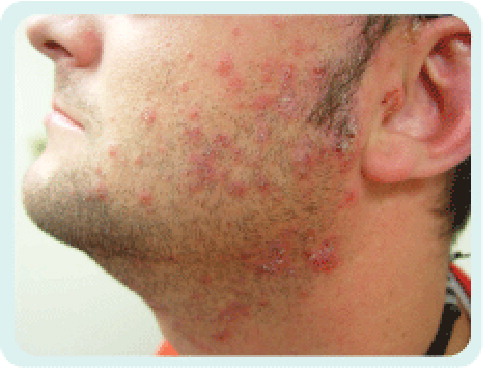Staphylococcus aureus is a leading cause of skin and skin structure infections (SSSIs), ranging from superficial conditions to deep-seated tissue involvement. These infections pose a significant burden in both community and hospital settings, with methicillin-resistant S. aureus (MRSA) presenting increasing therapeutic challenges. Rapid recognition, accurate diagnosis, and appropriate antimicrobial therapy are essential to prevent complications.

Pathophysiology and Mechanism of Infection
The skin acts as the primary defense barrier. S. aureus colonizes the anterior nares and broken skin, releasing an array of toxins and enzymes that disrupt epithelial integrity. This allows the bacteria to invade dermal and subcutaneous layers, leading to inflammation and pus formation.
Common Clinical Presentations of S. aureus Skin Infections
1. Impetigo
- Description: Contagious superficial infection, often in children
- Features: Honey-colored crusts, usually on face or extremities
- Causative Strain: Usually MSSA or MRSA
2. Folliculitis and Furuncles
- Description: Infection of hair follicles
- Features: Red, painful pustules; progression to boils
- Management: Warm compresses, topical mupirocin, drainage if necessary
3. Carbuncles and Abscesses
- Description: Deep infections of hair follicles with purulent collections
- Treatment: Incision and drainage; antibiotics for surrounding cellulitis or systemic signs
4. Cellulitis
- Description: Spreading infection of dermis and subcutaneous tissue
- Signs: Erythema, edema, warmth, tenderness, possible fever
- Risk Factors: Trauma, lymphedema, diabetes, immunosuppression
5. Wound Infections
- Description: Infections of surgical or traumatic wounds
- Indicators: Delayed healing, purulence, local inflammation
6. Necrotizing Skin Infections
- Description: Rapidly progressive infections with tissue destruction
- Urgency: Medical emergency requiring surgical debridement
Classification of Skin and Soft Tissue Infections
| Category | Examples | Severity | Typical Management |
|---|---|---|---|
| Superficial | Impetigo, folliculitis | Mild | Topical or oral antibiotics |
| Purulent | Abscesses, furuncles, carbuncles | Moderate | Drainage ± antibiotics |
| Non-purulent | Cellulitis, erysipelas | Moderate-Severe | Systemic antibiotics |
| Necrotizing | Fasciitis, myonecrosis | Severe | Surgery + broad-spectrum antibiotics |
Risk Factors and Predisposing Conditions
- Skin trauma or surgery
- Immunocompromised states
- Diabetes mellitus
- Obesity
- Poor hygiene or crowded living conditions
- Colonization with MRSA
- History of recurrent skin infections
Diagnostic Evaluation
Clinical Diagnosis
- Based on lesion morphology, symptoms, and presence of purulence
Microbiological Confirmation
- Wound Swab or Aspirate Culture: For purulent infections
- Blood Cultures: In febrile or systemic cases
- PCR Tests: Rapid MRSA detection if available
Imaging
- Ultrasound: To differentiate cellulitis from abscess
- MRI/CT: In suspected necrotizing or deep tissue involvement
Antimicrobial Treatment of S. aureus SSSI
Empiric Antibiotics
- MSSA:
- Cephalexin
- Dicloxacillin
- Clindamycin
- MRSA:
- TMP-SMX
- Doxycycline
- Clindamycin
- Linezolid (for severe infections)
Intravenous Therapy
- Severe MRSA Infections:
- Vancomycin
- Daptomycin
- Linezolid
Duration
- Uncomplicated: 5–10 days
- Complicated: Extend based on clinical response and infection depth
Non-Antibiotic Management Strategies
- Incision and Drainage: Primary therapy for abscesses
- Wound Care: Cleaning, debridement, dressing changes
- Hygiene Promotion: Prevent recurrence and transmission
- Decolonization: In recurrent cases (e.g., mupirocin nasal ointment, chlorhexidine washes)
Infection Control and Prevention Measures
Community Settings
- Avoid sharing personal items (towels, razors)
- Cover draining wounds
- Hand hygiene with soap or alcohol-based sanitizers
Healthcare Settings
- Adherence to contact precautions
- Screening and decolonization of high-risk patients
- Environmental cleaning and sterilization protocols
Complications of Untreated or Severe S. aureus SSSI
- Abscess formation
- Bacteremia
- Osteomyelitis
- Septic arthritis
- Endocarditis
- Necrotizing fasciitis
- Chronic wounds and scarring
Prognosis and Follow-Up Care
Timely intervention ensures excellent outcomes in most uncomplicated infections. Follow-up is essential in:
- Recurrent infections
- Immunocompromised individuals
- Persistent or worsening symptoms
- Cases requiring surgical debridement
Staphylococcus aureus skin and skin structure infections are a prevalent yet preventable cause of morbidity. With rising MRSA prevalence, clinicians must employ prompt diagnosis, appropriate antimicrobial stewardship, and comprehensive infection control practices. Preventive strategies in both community and healthcare environments are critical to curbing the spread and recurrence of these infections.

